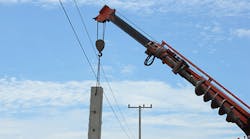Two King County (Washington) contractors face large fines from the state’s Department of Labor & Industries (L&I) for safety violations after a crane boom made contact with high-voltage power lines at a construction site in Seattle. Two workers were severely injured during the incident, when approximately 14 kilovolts traveled down the crane’s hoist line to the men working below the power lines.
As a result, Marpac Construction, of Seattle, has been cited for six workplace safety violations, including three “willful,” and fined $133,500. A subcontractor, Spartan Concrete of Kirkland, faces five violations, including two “willful,” and $90,000 in fines. Also, Shaffer Crane & Equipment Inc., another subcontractor, was cited for four violations – three “serious” and one “general” – with a total fine of $5,700.
The investigation began last September when local news outlets reported that two workers had been taken to Harborview Medical Center after suffering severe electrical burns.
L&I investigators at the site found that a mobile crane and a forklift with a crane-boom attachment had been operating under live high-voltage power lines. The power lines were scheduled to be moved underground, but rather than wait for that work to be done, the companies continued to work under them.
A Shaffer Crane employee was operating the crane and a Spartan foreman was giving signals when the incident happened. Seven workers were put at risk by being exposed to the potentially deadly electrical shock.
The Violations
The willful citations are for not ensuring that protective measures were in place and for not prohibiting work below energized power lines. Marpac was cited for an additional willful violation for not designating a qualified “lift director” who was aware of the voltages of the power line and the safety requirements for working around them. The investigation found that Marpac’s lift director was not aware of the voltages involved or the specific safety requirements.
Marpac also was cited for three serious violations related to inadequate training and for not ensuring an effective accident prevention plan, with penalties totaling $7,500.
The investigation found that Spartan’s employees were not trained or aware of the danger of working under power lines. Consequently, the concrete company was cited for two serious safety violations and fined $6,000 for not ensuring that employees clearly understood the hazards of overhead power lines and for lack of training and supervision. Spartan was also cited for one general violation for not holding and documenting walk-around safety inspections at the beginning of the job and weekly.
A willful violation is one where L&I finds evidence of plain indifference or an intentional disregard to a hazard or rule. A serious violation is one where there is a substantial probability that worker death or serious physical harm could result from a hazardous condition.
As a result of the violations and the severity of the injuries, both Marpac Construction and Spartan Concrete have been identified as severe violators and are subject to follow-up inspections to determine if the conditions still exist. The companies are appealing the citations.
Cranes and Power Lines a Known Hazard
The danger from a crane contacting overhead power lines is well-known. From 1999-2012, there were nine deaths in Washington from crane contacts with power lines, including a double fatality in 2010.
In 2012, L&I issued an alert to warn companies of the deadly hazard after receiving reports of six power line contacts by cranes over six months.
Companies operating cranes must make sure that all power line requirements are implemented. That includes putting protective measures in place to prevent crane booms from contacting energized power lines, designating a qualified “lift director” to ensure the safe operation of the crane and maintaining a safe radius from power lines.

